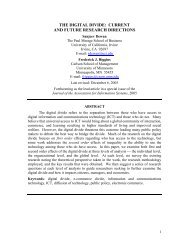When Should Software Firms Commercialize New Products ... - MISRC
When Should Software Firms Commercialize New Products ... - MISRC
When Should Software Firms Commercialize New Products ... - MISRC
You also want an ePaper? Increase the reach of your titles
YUMPU automatically turns print PDFs into web optimized ePapers that Google loves.
Jain, D., V. Mahajan, E. Muller. 1995. An approach for determining optimal product sampling for<br />
the diffusion of a new product. J. Prod. Innovation Management 12 124–1356.<br />
Jiang, Z., S. Sarkar. 2003. Free software offer and software diffusion: The monopolist case. Proc.<br />
24th Int’l Conf. Information Systems, Seattle, Washington, Dec.<br />
Jones, R., H. Mendelson. 2010. Information goods vs. industrial goods: Cost structure and compe-<br />
tition. Management Sci., forthcoming.<br />
Lehmann, D. R., M. Esteban-Bravo. 2006. <strong>When</strong> giving some away makes sense to jump-start the<br />
diffusion process. Marketing Letters 17(4) 243–254.<br />
Mahajan, V., E. Muller, R. A. Kerin. 1984. Introduction strategy for new produts with positive and<br />
negative word-of-mouth. Management Sci. 30(12) 1389–1404.<br />
Microsoft. 2008. Microsoft gives students access to technical software at no charge to inspire success<br />
and make a difference. Microsoft press release, Feb 18.<br />
Miller, C. C. 2009. Ad revenue on the Web? No sure bet. <strong>New</strong> York Times http://www.<br />
nytimes.com/2009/05/25/technology/start-ups/25startup.html? r=1.<br />
Mussa, M., S. Rosen. 1978. Monopoly and product quality. J. Econ. Theory 18 301–317.<br />
Parker,G.G., M.W. VanAlstyne.2005. Two-sidednetworkeffects: Atheoryofinformationproduct<br />
design. Management Sci. 51(10) 1494–1504.<br />
Raghunathan, S. 2000. <strong>Software</strong> editions: An applicaiton of segmentation theory to the packaged<br />
software market. J. Management Info. Sys. 17(1) 87–114.<br />
Riggins, F. J. 2003. Market segmentation and information development costs in a two-tiered fee-<br />
based and sponsorship-based web site. J. Management Info. Sys. 19(3) 69–86.<br />
Rochet, J. C., J. Tirole. 2003. Platform competition in two-sided markets. J. European Econ. Assoc<br />
1(4) 990–1029.<br />
Rochet, J. C., J. Tirole.2006. Two-sided markets: a progressreport. RAND J. Econ. 37(3) 645–667.<br />
Sixteen Ventures. 2010. The reality of freemium in SaaS. http://sixteenventures.com/blog/the-<br />
reality-of-freemium-in-saas.html.<br />
Trusov, M., R. E. Bucklin, K. Pauwels. 2009. Effects of word-of-mouth versus traditional marketing:<br />
findings from an Internet social networking site. J. Marketing 73(5) 90–102.<br />
Wei, X., B. Nault. 2005. Product differentiation and market segmentation of information goods.<br />
Working paper, University of Calgary (available at SSRN: http://ssrn.com/abstract=909604).<br />
Wu, S., P. Chen. 2008. Versioning and piracy control for digital information goods. Oper. Res. 56(1)<br />
157–172.<br />
31
















